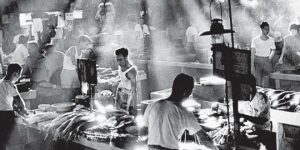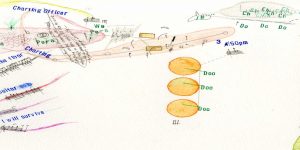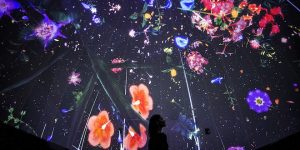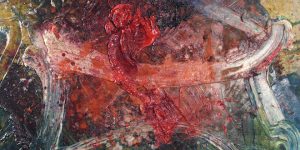‘Cinerama: Art and The Moving Image in Southeast Asia’ exhibition at Singapore Art Museum
A reflection on ‘Cinerama: Art and The Moving Image in Southeast Asia’

Ming Wong, ‘Making Chinatown’ (video still). Image courtesy the artist, Vitamin Creative Space, Guangzhou and calier | gebauer, Berlin.
‘Cinerama: Art and The Moving Image in Southeast Asia’ is the Singapore Art Museum’s latest exhibition, on view from 17 November 2017 to 18 March 2018 at SAM at 8Q. Presenting works from 10 contemporary artists and collectives from the region, this exhibition explores how the medium of the moving image is engaged and transformed to ask questions about memory, identity and politics. The works surveyed include a range of artistic strategies from laborious hand-drawn animation to music videos and immersive installations.
In fact, visiting this exhibition isn’t too different from watching a movie at the theatre. The works are time-based and experiential, and ask for an investment in your attention. Just as one rarely (probably never) views a movie through the viewfinder of a phone camera, I think it is fair to make a similar point for this exhibition. Aptly too, as a key theme is the function of the moving image or cinema as a record of the time, with all its implications for history and memory.
Cambodian-born Amy Lee Sanford’s ‘Scanning’ is a poetic meditation on the moving image as documentation. In this video, Sanford carefully scans and flips fragile “onion-skin thin” letters which evidence an exchange between her adoptive mother in the United States and her biological father who remained in Phnom Penh during the Cambodian civil war between 1970 and 1975. Presented as a wall-sized video projection, the letters take on a monumental scale with every cease and fold magnified. What you are looking at is essentially a performance of the recording process, or in the words of the curator Andrea Fam: “an almost forensic activity that enacts a means of remembering”. A gesture, each registered by the harsh pillar of light as the scanner sweeps from the left to right before the process is repeated. Even though the scanner is supposed to capture, in light and image, these words and memories, I can’t help but feel that its sheer intensity seem to burn right through the sheets. Simultaneously, a re-activation and a release; clear yet undecipherable.
This authorial quality of light dissolves into a play of light and shadow in ‘A White, White Day’, an installation of lightboxes by Singapore artist Jeremy Sharma. The work sits at the end of a rectangular black gallery, like movie theatre setup. However instead of a projection, the video is played through light emitted from LED nodes which diffuses on the lightboxes’ surface. The resultant image has inconsistent levels of clarity and a range of tones, a quality evocative of the Impressionist painters’ experiment with light and colour. The film re-interpreted is ‘Korban Fitnah’ (1959), an old Cathay Keris production notable for its portrayal of pre-independence Singapore and locations which no longer exist such as Outram Prison and the Keppel Road Customs House. Indeed, this replaying of history has a spectral dimension, the figures become formless ghosts in the chiaroscuro.

Jeremy Sharma, ‘A White, White Day’ (artist impression), 2017. Image courtesy the artist.
At timed intervals, overhead horn speakers break the silence of the space with a soundtrack from the movie: ‘Burung Dalam Sangkar’ (Bird in a Cage). It is melodic and perhaps even nostalgic, but one feels an under-the-skin, uncanny sensation as the room quietens after. And the screen stares back…
‘Making Chinatown’ by Ming Wong is another dive into the uncanny as he retells Roman Polanski’s classic 1974 film, ‘Chinatown’ by casting himself as its main characters. Wong problematises the constructions of identity and gender by performing multiple characters in the same scene. This simulacrum extends into the backdrop of Wong’s videos which are stills from the original film printed on wooden screens. These backdrops are then re-presented to form a makeshift studio set installation, a layered deconstruction of the artifice in cinematic production.
Going from behind the scenes into another simulation, drama on the screen extends into the space in the form of a site-specific installation comprising fur-lined walls and a floor encrusted with earth, seashells and other found materials. Welcome to Korakrit Arunanondchai and Alex Gvojic’s ‘There’s a word I’m trying to remember, for a feeling I’m about to have (a distracted path towards extinction)’. The video presented is an opera weaving real life events (Arunanondchai’s brother’s wedding) with an imagined post-apocalyptic future, spliced together in a collage with recurring visual motifs. It is a heady mix mirroring our contemporary lives, a cloud where memory, fact and imagination collapse.

Korakrit Arunanondchai and Alex Gvojic, ‘There’s a word I’m trying to remember, for a feeling I’m about to have (a distracted path towards extinction)’, 2016-17. Image courtesy the artists.
Can one be hopeful for the future? The retro aesthetics of pixel art might suggest the potential of reuse and recycling to be a way out of the game. oomleo’s ‘Maze Out’ is a GIF animation, accompanied with a punchy upbeat soundtrack and sticker installation which the artist invites the audience to expand. Irresistibly, I took two stickers like everyone else: one for the wall and one as a souvenir. Peeling away the protective backing, the stickers reveal themselves to be printed on transparent plastic with tinted colours. omlee’s characters jumped from his computer screen to the wall, and now I am carrying one in my notebook. The page or any white surface is instantly flattened into the pixel plane, transformed into a screen. It is, perhaps optimistically, a carte blanche for new narratives and possibilities.
More information at singaporeartmuseum.sg.
This article was witten by Ian Tee for Art Republik.









